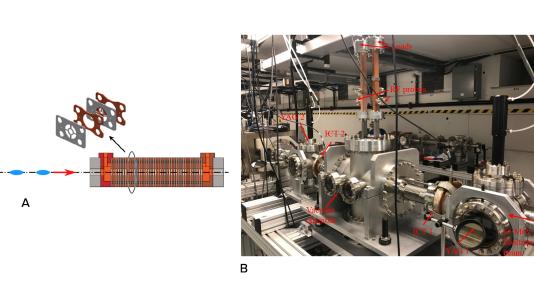
Scientific Achievement
We have designed, built and tested a new type of accelerator structure that promises to make future accelerators more attractive by being smaller and cheaper. The accelerator uses a periodic metallic metamaterial structure in the shape of a stack of “wagon wheel” discs to control the microwaves generated in the acceleration process. The critical test of the new concept occurred at Argonne National Laboratory’s Wakefield Accelerator facility.
Significance and Impact
These results demonstrate the unique features of metamaterial structures that are very attractive for future high-gradient wakefield accelerators, including two-beam and collinear accelerators.
Research Details
In the test, a beam of electrons passed through the hollow central hubs of the wagon wheel discs generating a nanoseconds-long pulse of 80 MW of microwave power, in very good agreement with advanced computer simulations. A future test is planned to achieve output power levels in the gigawatt range. Advantages include the high shunt impedance for high power generation and high-gradient acceleration, the simple and rugged structure, and a large parameter space for optimization.
Collaborating Institutions
- Argonne National Laboratory
- MIT Plasma Science and Fusion Center and Dept. of Physics
Acknowledgment
This research was supported by the U.S. Department of Energy, Office of Science, Office of High Energy Physics under Award No. DE-SC0015566. The work at the Argonne Wakefield Accelerator Facility is funded through the U.S. Department of Energy, Office of Science under Contract No. DE-AC02-06CH11357.
Publication
Xueying Lu, Michael A. Shapiro, Ivan Mastovsky, Richard J. Temkin, Manoel Conde, John G. Power, Jiahang Shao, Eric E. Wisniewski, and Chunguang Jing. “Generation of high-power, reversed-Cherenkov wakefield radiation in a metamaterial structure,” Phys. Rev. Lett., Vol. 122, 014801 (2019).
Argonne National Laboratory seeks solutions to pressing national problems in science and technology. The nation’s first national laboratory, Argonne conducts leading-edge basic and applied scientific research in virtually every scientific discipline. Argonne researchers work closely with researchers from hundreds of companies, universities, and federal, state and municipal agencies to help them solve their specific problems, advance America’s scientific leadership and prepare the nation for a better future. With employees from more than 60 nations, Argonne is managed by UChicago Argonne, LLC for the U.S. Department of Energy’s Office of Science.
The U.S. Department of Energy’s Office of Science is the single largest supporter of basic research in the physical sciences in the United States and is working to address some of the most pressing challenges of our time. For more information, visit https://energy.gov/science.